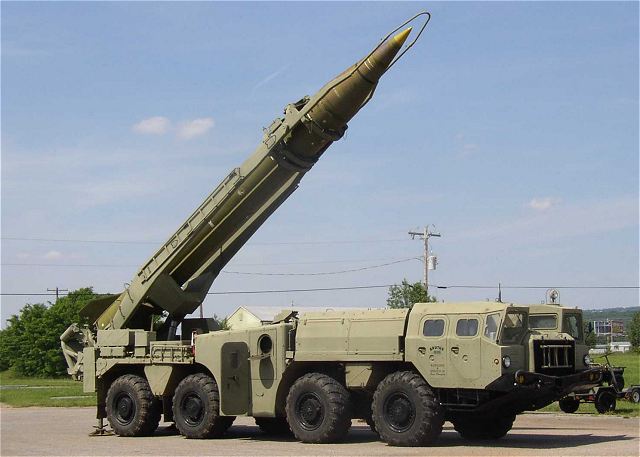
Russian-Made SS-1 SCUD medium range ballistic missile
Today in 1987, the Missile Technology Control Regime (MTCR) was established by seven countries, including the U.S., in order to control the spread of unmanned delivery systems for weapons of mass destruction, and to coordinate national export licensing efforts aimed at preventing their proliferation. The regime, which has since expanded its membership to thirty-four (plus Israel, Romania, and the Slovak Republic, which, while not members, have each committed to maintaining export controls consistent with the regime) just concluded its twenty-fifth plenary in Buenos Aires, Argentina.
According to the Arms Control Association, “the MTCR has been credited with slowing or stopping several missile programs by making it difficult for prospective buyers to get what they want or stigmatizing certain activities and programs. Argentina, Egypt, and Iraq abandoned their joint Condor II ballistic missile program. Brazil, South Africa, South Korea, and Taiwan also shelved or eliminated missile or space launch vehicle programs. Some Eastern European countries, such as Hungary, Poland and the Czech Republic, destroyed their ballistic missiles, in part, to better their chances of joining MTCR. The regime has further hampered Libyan and Syrian missile efforts.” Members, including the U.S., Japan and others have often used their history of strict adherence to the MTCR guidelines in order to pressure non-member countries to comply.
But, like all other international regimes, particularly voluntary ones, the MTCR has had its problems. In fact, such a commemoration smacks of profound irony given the events on the less pleasant side of the DMZ last week. India was also able, despite the MTCR, to establish a largely self-sufficient space-launch and ballistic-missile program, while Pakistan procured missiles and turn-key production facilities from North Korea and China, neither of which are MTCR members. Iran acquired an initial stockpile of missiles from North Korea, and used production infrastructure it received from China to establish an indigenous capacity to produce solid-fuelled missiles. Unbound by MTCR guidelines, the DPRK has also been a leading supplier of short- and medium-range missiles and related technologies for more than 20 years.
So, does the MTCR still matter, despite its failings?
The London-based International Institute for Strategic Studies (IISS) believes the answer is yes. Despite the fact that the MTCR ” has not been as successful at curtailing the spread of cruise missiles, and nor is it structured to regulate the development of unmanned aerial vehicles (UAVs)”, no additional states have established a viable intercontinental ballistic missile (ICBM) capability since 1987, and only Israel and India have created missiles with a range of more than 3,000 kilometers.
BUT, and this is a big but, two key challenges facing the regime today remain. While the MTCR arose from concerns that nations pursuing nuclear weapons might also seek long-range delivery systems, IISS suggests that control of cruise missiles and unmanned aircraft still need to be addressed. When it was established in 1987, “Less attention… was paid to cruise missiles and non-nuclear payloads. Consequently, the MTCR has been less effective in curtailing the threat posed by cruise missiles capable of carrying chemical, biological or nuclear weapons. For these, a different set of criteria is needed.
“Cruise missiles need not fly long distances to strike targets, since they are relatively small and can be launched from simple platforms located inside or outside a country’s borders, including ships at sea. Stealth, speed and maneuverability are key performance criteria. If the MTCR were updated to reflect these new realities, highly manoeuvrable, hypersonic cruise missiles capable of carrying more than 500kg would be regulated as Category I items, regardless of range. Similarly, emerging technologies such as radar-absorbing materials and designs, miniaturized propulsion systems and high-precision navigation and guidance units would be more tightly controlled.”
However, attempts at changes to better address these loopholes have not yet been successful. For example, Russia and others have opposed a US and UK proposal to amend the regulations to include restrictions on the transfer of hypersonic, short-range cruise missiles.
In light of what is continuing to happen in Iran, India, North Korea and Pakistan, the question is, is altering the MTCR to address UAVs and cruise missiles now a day late and a rupee short?